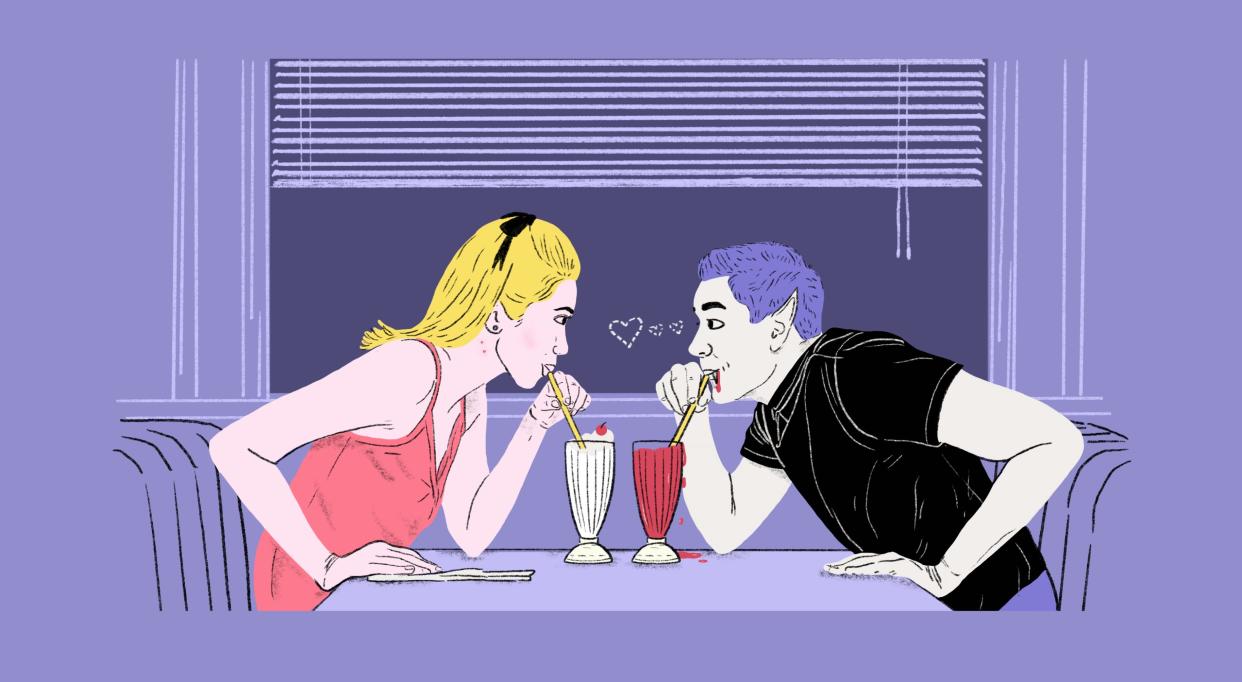Paranormal romance books, explained: Why this supernatural genre has readers swooning

You can say a lot of things about the “Twilight” books and movies, but you can’t say they didn’t make an impact. The campy romance ushered in a renewed interest in paranormal love stories (and fan fiction).
The paranormal romance genre exists a bit at the fringes. It has a diehard fan base, of course, but you likely won’t find swoon-worthy supernatural creatures as the next Reese’s Book Club pick.
It’s also much more than vampires and werewolves. Here’s what makes the genre so alluring to readers.
What is paranormal romance?
Paranormal romance falls under the broader romance category and, as the name suggests, contains otherworldly characters or elements in a recognizable world. While romantasy (a portmanteau of “romance” and “fantasy”) is usually fully fantastical, paranormal romance is set closer to reality.
As such, the paranormal details often have an element of absurdity – a ghost, alien, witch or fairy showing up in a non-magical society. In some stories, a human character falls in love with a paranormal one, like a werewolf or a vampire. In others, both characters exist in a paranormal context.
Even still, recent releases are blurring the lines between paranormal romance and romantasy. New releases have monsters and dragons, typical of strict fantasy novels. Some play with contemporary romance tropes, says Niah Freed, a BookTok influencer.
“People are taking more risks when it comes to paranormal romance,” Freed says.
Diverse human characters are among those updates as well. Freed, who has been a paranormal romance reader since she was in middle school, noticed older books often centered around a “shrinking violet” white, female protagonist who needs a hunky male (insert paranormal character here) to save her. Newer releases are more diverse, featuring strong-willed leads of color or queer storylines.
“People are more receptive about wanting to have characters that are layered and that are able to feel and be multifaceted,” Freed says.
Why you should read paranormal romance
Escapism is a key draw for the paranormal romance genre.
“It lets (readers) explore a romance perhaps that they wouldn’t have been able to experience in our world,” says Lizzy Mason, publicity director at Entangled Publishing. “One of the main elements that I love about romantasy and paranormal romance is that it usually has such an unputdownable, immersive reading experience.”
Themes of empowerment – female agency, self-actualization and choice – also make the genre enticing.
And for romance readers, it’s an easier genre to ease into than diving headfirst into fantasy, says Ashley Doliber, the senior director of marketing strategy at Entangled Publishing.
“Oftentimes those stories, at least traditionally, are set in our modern world so it feels recognizable and feels a little bit more like your daily life,” Doliber says.
“Vampires are hot,” Freed also jokes. “I’m positive that’s probably the reason I picked up my very first one. It was not deep.”
Freed is a fantasy reader. She loves a book that takes her outside of reality and stretches her imagination. Paranormal romances do just that. But it’s not just a genre for romance or fantasy lovers, says Freed. She’d recommend the genre to any type of reader. Because it’s so established, there’s something for everyone.
Common paranormal romance tropes
Like its peers in the broader genre, paranormal romances often follows romance tropes, but with fantastical twist.
There’s the “fated mate” or “true mate” trope, where a character has one match just for them. It makes for a comforting read, Freed says, knowing “no matter what I do, or what happens, this person is always going to love me.”
But sometimes, pairings start a little rockier. You may see the “enemies to lovers” or even “friends to lovers” tropes. They’re not as common in paranormal romance as they are in classic romance, but newer books lean on them more, Freed says.
There’s often one “alpha” or more dominant character, typically in werewolf stories (though the shoe can certainly fit with other paranormal duos). It may go hand-in-hand with the “touch her and you die” trope, where the alpha character will do anything to protect their lover.
Perhaps most beloved by readers is the “outsider” trope. These supernatural creatures exist on the outskirts of society, either because they can’t relate to others or because they’ve been pushed there – that changes when they find love and unexpected community.
“That probably really resonated with me when I was 12 and 13,” Freed says. “It still does and probably always will.”
Best paranormal romance books
“Twilight” by Stephanie Myers is one of the most well-known paranormal romances, but that doesn’t mean it has to be your first foray into the genre. Here are some reads that Freed, Mason and Doliber recommend:
“Bride” by Ali Hazelwood
“Dark City Omega” by Elizabeth Stephens
“Mating the Huntress” by Talia Hibbert
“Two Scoops of Hellfire” by Kimberly Lemming
“Angels' Blood” by Nalini Singh
“Dark Lover” by J.R. Ward
“The Undertaking of Hart and Mercy” by Megan Bannen
“Witchful Thinking” by Celestine Martin
“Cemetery Boys” by Aiden Thomas
“Payback's a Witch” by Lana Harper
“Even Though I Knew the End” by C.L. Polk
“The Wren in the Holly Library” by K.A. Linde
“Sweet Nightmare” by Tracy Wolff
Try cozy mystery next: How this genre combines crime with comfort
Just Curious for more? We've got you covered.
USA TODAY is exploring the questions you and others ask every day. From "How to return a book on Audible?" to "What makes the best children's book?" to "How to write a poem" – we're striving to find answers to the most common questions you ask every day. Head to our Just Curious section to see what else we can answer for you.
This article originally appeared on USA TODAY: Paranormal romance books deal in otherworldly love (literally)

